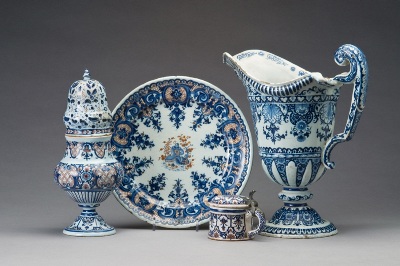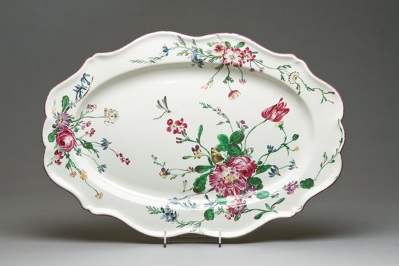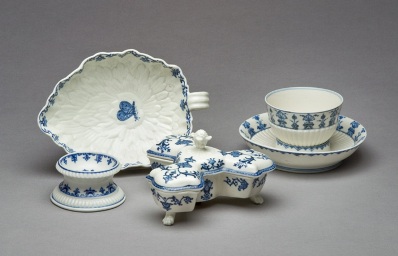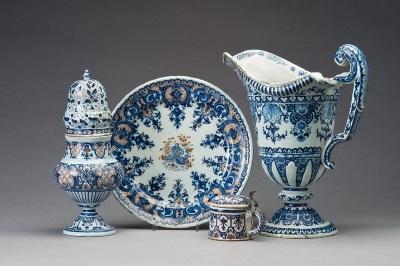Although it can be vigorously debated at what point an object transcends a mere utilitarian purpose to achieve recognition as a work of art, decorative arts—aesthetically appealing pieces capable of bringing significant pleasure to daily activities—can successfully satisfy both criteria. Myriad vessels and wares serve practical needs, yet a dinner service displaying a coat of arms also proudly conveys a family’s heritage, a chinoiserie cup and saucer can transport the imagination of the imbiber to foreign ports teeming with exotic goods, and a mustard pot decorated with a cadre of frolicking monkeys can delight diners. The ideal fusion of the useful and the beautiful that is found in French faïence, soft- and hard-paste porcelain, is the essence of what inspired MaryLou Boone to assemble her outstanding collection of more than 130 pieces, now on view in the exhibition Daily Pleasures: French Ceramics from the MaryLou Boone Collection, which opened this weekend. The selection of pieces in the collection attests to MaryLou’s discriminating, sophisticated eye, but what she values most about them is the simple fact that people used and enjoyed these ceramics on a daily basis.

Caster, Plate Mustard Pot and Ewer; 1700–1730, Rouen, France, earthenware with tin glaze and enamel (grand feu faïence)
This exhibition and accompanying catalogue not only bring together years of MaryLou Boone’s discerning acquisitions but also recognize a substantial gift to the two institutions that Mrs. Boone and her late husband, Dr. George Boone, have generously supported and passionately championed: LACMA and the Huntington Library, Art Collections, and Botanical Gardens. The Boones established a longstanding relationship at LACMA, where Dr. Boone served as a life trustee and the couple endowed the popular Boone Children’s Gallery. Similarly, the Boones have been benefactors of the Huntington for decades and are the namesakes of its special exhibitions gallery. There, MaryLou served as a trustee (now a trustee emeritus) and assiduously promoted the museum’s collection of French art as one of the institution’s true strengths. In 2010, MaryLou gave approximately twenty-five pieces from her collection to each museum, significantly enhancing their holdings and bringing new life to their permanent collection galleries. The gifts feature outstanding works ranging from the 1640s through the 1860s, made by the foremost manufacturers of French faïence and soft-paste porcelain, which were successive attempts to mimic hard-paste porcelain imported into Europe from Asia.

Cup and Saucer, and Sugar Box, c. 1746–1748, Vincennes Porcelain Manufactory, France, 1740–1756, soft-paste porcelain with glaze and enamel
Earthenware with an opaque tin glaze was introduced to France in the mid-sixteenth century from Italy, where it had been made for several centuries. Called maiolica there, it became known as faïence in France, as the Italian city Faenza was a center for maiolica production. The French had already embraced the imported Italian wares, so when Italian émigré ceramists bearing the secrets of tin-glazed earthenware production journeyed up the Rhône valley and settled in France, native manufactories flourished. Mrs. Boone’s collection of faïence contains both grand feu (high fire) faïence and petit feu (low fire) faïence. Named for the high temperatures at which it is fired, grand feu faïence allowed ceramists a viable means for creating detailed decoration, but the high firing temperatures limited the color palette to blue, green, yellow, purple and iron red, since other hues could not withstand the heat. Introduced in France in the mid eighteenth century, petit feu faïence featured a much broader color palette by employing a second firing at a lower temperature. This technique preserved the vividness of the more instable hues and enabled both translucent and opaque colors to be produced, which included a much wider range of pinks, greens, blues and violets

Oval Dish, c. 1770, Joseph-Gaspard Robert Manufactory, Marseilles, France, c. 1750–1800, earthenware with tin glaze and enamel (petit feu faïence)
Endeavoring to uncover a successful technique for producing hard-paste porcelain, French ceramic manufactories experimented with different ways to achieve the translucency and strength of Asian wares. As they had not yet discovered kaolin clay, the vital ingredient for hard-paste porcelain, they used ingredients such as ground glass and fine clay which necessitated a lower firing temperature. This type of porcelain is less resilient than hard-paste, and is known as soft-paste porcelain, or pâte tendre. The Boone Collection includes significant works from the most important French soft-paste porcelain manufactories, including Saint-Cloud, Chantilly, Mennecy, Sceaux, and Vincennes, which later became Sèvres, producers of the first French hard-paste porcelain, examples of which are also represented in the collection. These burgeoning technological breakthroughs allowed for the production of a diverse array of forms, decorations, and color palettes, all of which were put to use in daily context.

Saltcellar, Hors d’Oeuvres Dish, Pepper Box and Trembleuse Cup and Saucer; c. 1700–1750, Saint-Cloud Manufactory, France, c. 1693–1766, soft-paste porcelain with underglaze blue and glaze
Dining wares, drinking vessels, and serving pieces accommodated expanding menus created from a variety of new foods, prepared in novel ways. Faïence and porcelain were also the media called upon by pharmacists and caregivers in which to prepare and administer mixtures that comforted in times of sickness, and by fashionable men and women in which to store the many powders and toiletries necessary for a stylish appearance. The air was perfumed by fragrant floral blends emanating from ceramic potpourris, the ritual of taking snuff featured fanciful boxes dramatically drawn from one’s pocket, and the routine tasks of penning letters or drafting documents were made pleasurable through cleverly conceived writing sets. After the 1768 discovery of kaolin, the French were able to produce hard-paste porcelain, and faïence and soft-paste porcelain gradually declined. Even so, faïence and soft-paste porcelain ultimately became distinctive and sought-after ceramics in their own right. Inextricably intertwined with everyday human duties and diversions, these objects continue to bring pleasure to daily life.
Elizabeth Williams, Marilyn B. and Calvin B. Gross Assistant Curator, Decorative Arts and Design



